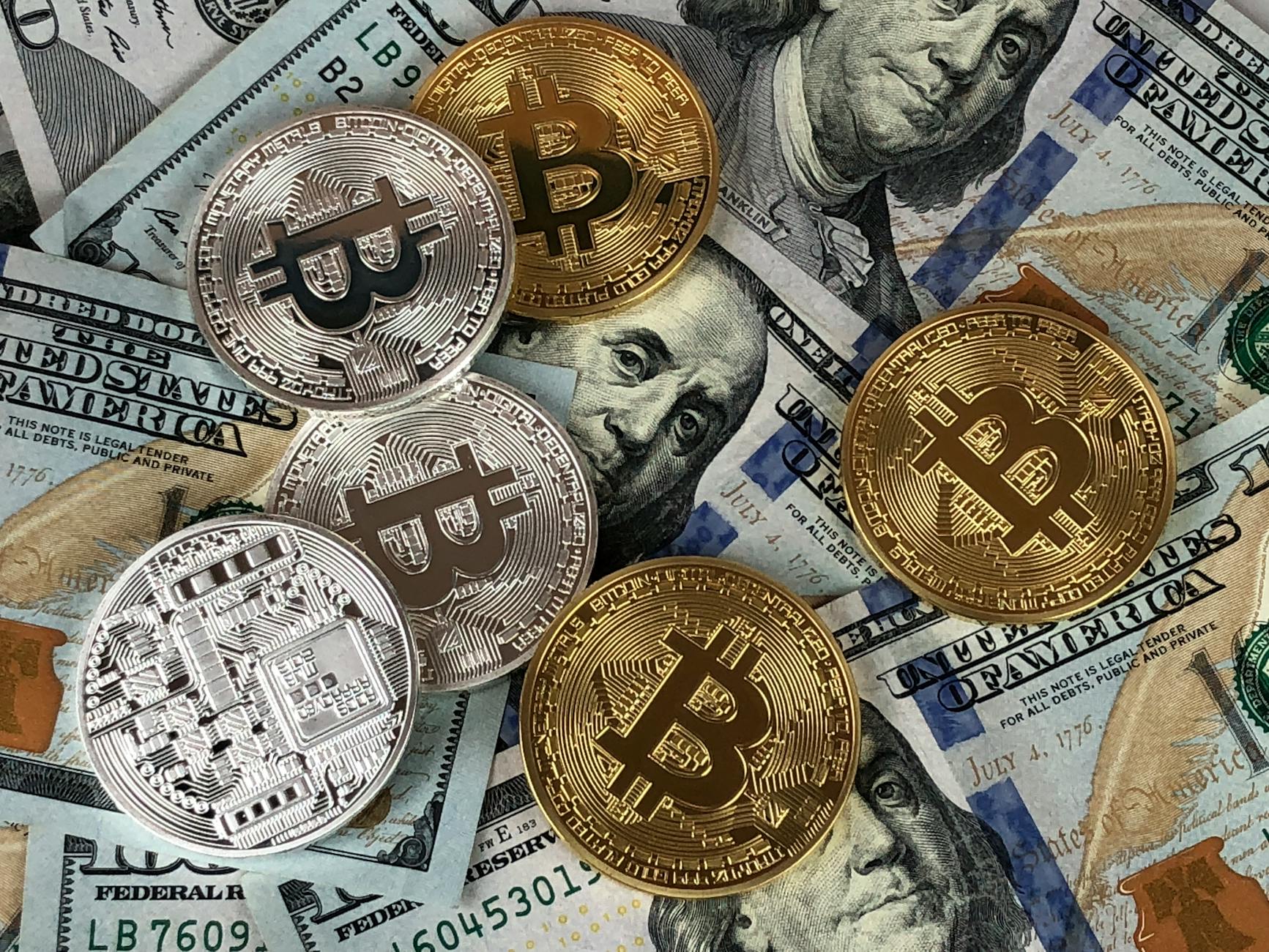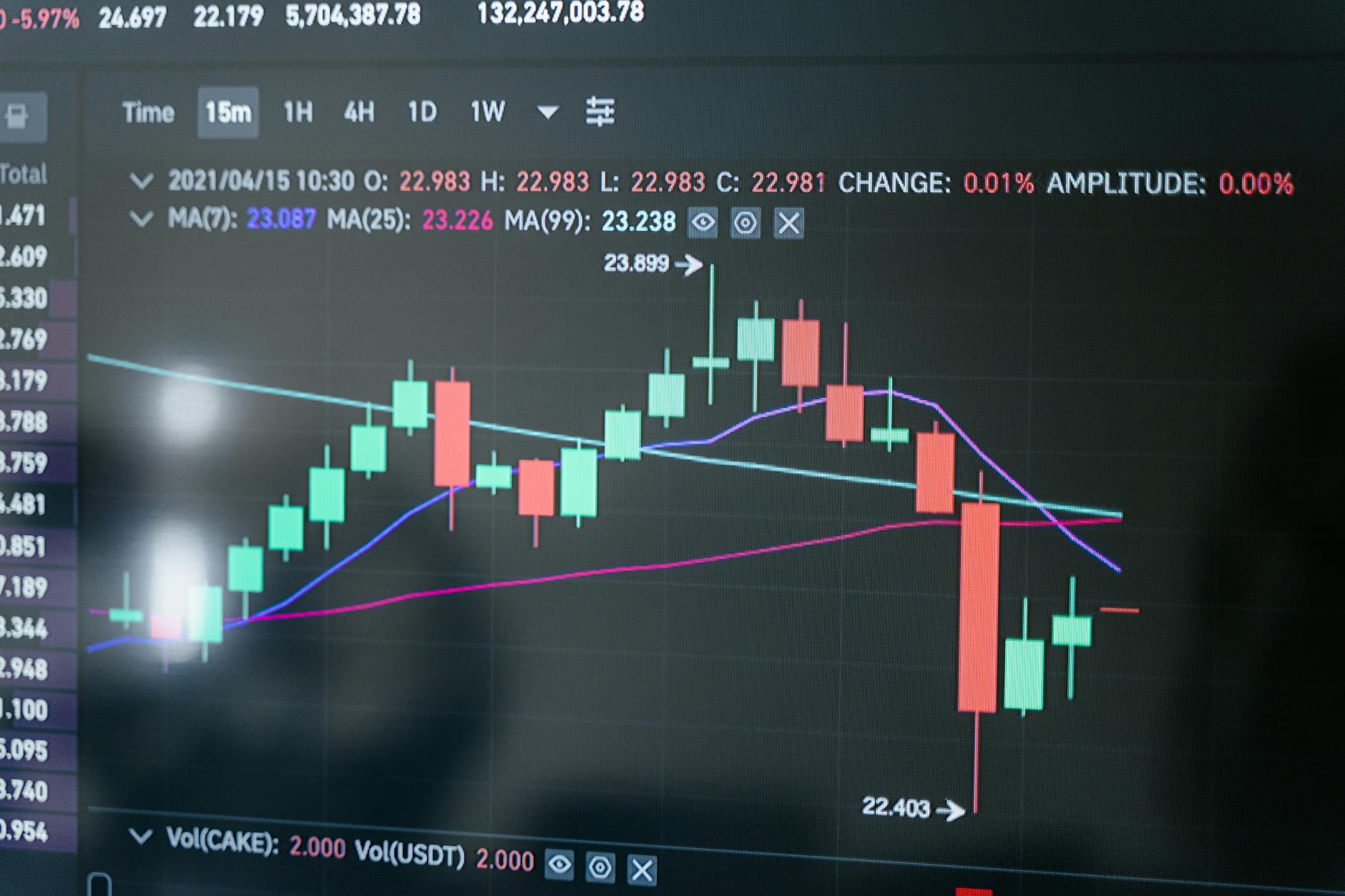The Crypto Market’s Year-End Blues: Profit-Taking and Fed Hawkishness Drag Down Prices
As the year draws to a close, the cryptocurrency market finds itself navigating a turbulent period, with established investors cashing out and a less-than-accommodating Federal Reserve adding to the downward pressure.
The cryptocurrency market experienced a predominantly bearish trend for the majority of the past week. This downturn, a familiar pattern as the calendar year concludes, is largely attributed to significant profit-taking by institutional investors who are closing out their positions. However, the Federal Reserve’s hawkish stance, articulated at its December 18th policy meeting, has also played a crucial role in dampening investor sentiment and contributing to the price declines across major cryptocurrencies. This confluence of factors has led to a noticeable drop in Open Interest (OI) for key digital assets, signaling a potential cooling-off period for speculative trading.
This analysis delves into the primary drivers behind the recent price slump, examining the interplay between institutional behavior and macroeconomic policy. We will explore the implications of these trends for Bitcoin and other major cryptocurrencies, providing a comprehensive overview of the current market landscape. By dissecting the reasons for the selloffs and the impact of the Fed’s decisions, we aim to offer a clear picture of the challenges and opportunities facing the crypto space as it heads into the new year.
The cyclical nature of investment, particularly at year-end, often sees a redistribution of capital. For cryptocurrencies, which have seen remarkable growth in certain periods, this profit-taking can be substantial. Coupled with shifts in monetary policy, which can influence risk appetite across all asset classes, the crypto market is currently grappling with a multifaceted set of headwinds. Understanding these dynamics is essential for anyone looking to navigate the volatile world of digital assets.
Introduction
The cryptocurrency market, a realm known for its exhilarating highs and precipitous lows, is currently experiencing a significant downturn as the year draws to a close. The past week has been characterized by a consistent downward trend across major digital assets, with Bitcoin and its counterparts shedding value. This bearish sentiment is not an isolated event but rather a culmination of several key factors, with yearly profit-taking by institutional investors standing out as a primary catalyst. As corporations and large investment funds begin to close out their books for the year, they often liquidate profitable positions, a common practice across all financial markets. However, in the nascent and often more volatile crypto market, these selloffs can have a more pronounced impact.
Adding to this pressure is the Federal Reserve’s increasingly hawkish stance, a sentiment that was clearly communicated following their December 18th policy meeting. In an environment where the Fed signals a tightening of monetary policy, possibly through interest rate hikes or a reduction in asset purchases, the appetite for riskier assets like cryptocurrencies tends to diminish. Investors often shift towards safer, more traditional investments, leading to capital outflows from speculative markets. This macroeconomic backdrop creates a challenging environment for crypto assets, which are still viewed by many as inherently risky.
The observable impact of these combined forces is evident in the declining Open Interest (OI) across major cryptocurrencies. Open Interest represents the total number of outstanding derivative contracts (like futures and options) that have not been settled. A consistent decline in OI suggests that traders are less inclined to take new positions or are closing out existing ones, reflecting a reduction in speculative activity and a general bearish outlook. This article will provide a comprehensive analysis of these weekly price movements, examining the underlying causes and their potential implications for the broader cryptocurrency market.
Context & Background
To fully grasp the current market dynamics, it’s crucial to understand the broader context within which these price movements are occurring. The cryptocurrency market, despite its growing maturity, remains highly susceptible to both internal and external influences. On the internal front, the market is driven by technological developments, adoption rates, regulatory news, and the sentiment of retail and institutional investors. Externally, macroeconomic factors such as inflation, interest rate policies, geopolitical events, and the performance of traditional asset classes significantly impact crypto prices.
In the recent past, cryptocurrencies, particularly Bitcoin, have experienced periods of explosive growth, driven by increasing institutional adoption, the narrative of Bitcoin as a digital store of value, and the general exuberance in risk assets. This has attracted significant capital, leading to new all-time highs and a surge in trading volumes. However, such rapid appreciation often leads to periods of consolidation and correction as early investors look to realize their gains. The concept of “yearly selloffs” is a well-established phenomenon in traditional finance, where fund managers rebalance portfolios, lock in profits, or cut losses before the end of the fiscal year.
The Federal Reserve’s monetary policy plays a pivotal role in shaping the global financial landscape. For years, the Fed maintained a dovish stance, characterized by low-interest rates and quantitative easing, which provided a fertile ground for speculative assets like cryptocurrencies to flourish. However, as inflationary pressures have mounted, the Fed has signaled a shift towards a more hawkish stance. This typically involves increasing interest rates to curb inflation and reducing the money supply. A tightening monetary policy generally leads to an increase in the cost of capital, making borrowing more expensive and reducing the attractiveness of high-risk, high-return investments. When the Fed signals a more aggressive approach to tightening, as it did on December 18th, it sends ripples across all asset classes, and cryptocurrencies are not immune.
The December 18th Fed meeting is a critical reference point. While the summary of the meeting itself is not provided in detail, the mention of a “hawkish stance” suggests that the Federal Reserve either raised interest rates, signaled a faster pace of future rate hikes, or announced a more aggressive tapering of its asset purchase programs. Any of these actions would signal a move away from accommodative monetary policy, which historically tends to dampen the performance of riskier assets. For cryptocurrencies, which have benefited immensely from an era of cheap money, this shift can be a significant headwind.
Furthermore, the concept of Open Interest (OI) is a key indicator for traders and analysts. In the context of derivatives markets (futures and options), OI provides insight into the overall activity and sentiment. A rising OI generally accompanies a price trend, suggesting that new money is entering the market and participants are confident in the direction. Conversely, a declining OI, especially during a price decline, can indicate that existing positions are being closed out, potentially signaling a weakening of the trend or a lack of conviction from new participants. The reported weekly declines in OI for major cryptos underscore the prevailing caution and reduced speculative interest in the market.
Understanding these interconnected factors – the cyclical nature of investment, the Fed’s monetary policy, and the behavior of traders as reflected in OI – is essential for a nuanced interpretation of the current market downturn. The past week’s price action is not just a random fluctuation but a response to deliberate market forces and policy decisions.
In-Depth Analysis
The past week’s consistent downward price action in the cryptocurrency market is a multifaceted phenomenon, driven by a potent combination of year-end profit-taking and the Federal Reserve’s hawkish monetary policy signals. To dissect these influences, we must first examine the mechanics of institutional selling pressure and then explore the broader economic implications of the Fed’s recent pronouncements.
Yearly Selloffs and Institutional Profit-Taking: As the end of the calendar year approaches, institutional investors, including hedge funds, asset managers, and even corporate treasuries that have allocated capital to cryptocurrencies, often engage in portfolio rebalancing and tax-loss harvesting. This involves selling profitable positions to lock in gains for the year and potentially offsetting capital gains with losses from underperforming assets. In the cryptocurrency market, which has seen substantial gains for some assets over the past year, this practice can lead to significant selling pressure. Institutions, managing vast sums of capital, can move the market considerably when they decide to liquidate substantial holdings.
The summary notes that “yearly profit-taking is a major reason for price declines as institutions close positions for the year.” This implies that a considerable portion of the selling volume seen last week was driven by this predictable, albeit impactful, market behavior. For Bitcoin, which often acts as a bellwether for the broader crypto market, a significant sell-off from large holders can trigger cascading liquidations in the derivatives market and encourage retail investors to follow suit, fearing further declines.
The Federal Reserve’s Hawkish Stance: The Federal Reserve’s policy decisions are a significant external factor influencing all asset classes, including cryptocurrencies. The summary explicitly states that “the Fed’s hawkish stance at the Dec. 18 policy meeting also played a role.” A “hawkish stance” by the Fed typically signals an intent to tighten monetary policy, which can manifest in several ways:
- Interest Rate Hikes: Raising the federal funds rate increases the cost of borrowing money. This makes it more expensive for businesses and individuals to finance investments, potentially slowing economic growth and reducing liquidity in the market.
- Quantitative Tightening (QT): This involves the Fed reducing its balance sheet by selling assets it purchased during quantitative easing (QE) or allowing them to mature without reinvestment. QT reduces the overall money supply in the economy.
- Accelerated Tapering of Asset Purchases: The Fed might signal a faster reduction in its monthly purchases of Treasury bonds and mortgage-backed securities. This also signals a move towards less accommodative monetary policy.
In an environment of rising interest rates and tightening liquidity, investors tend to become more risk-averse. Assets that are perceived as riskier or more speculative, such as growth stocks and cryptocurrencies, often underperform. This is because higher interest rates increase the “risk-free rate” of return (e.g., from government bonds), making less risky investments more attractive relative to volatile assets. Furthermore, a hawkish Fed can strengthen the U.S. dollar, which can put downward pressure on dollar-denominated commodities and assets, including many cryptocurrencies.
The specific details of the December 18th meeting are crucial here. If the Fed signaled a more aggressive pace of rate hikes than previously anticipated, or a quicker end to its asset purchase program, this would naturally lead to a reassessment of asset valuations across the board. Crypto investors, accustomed to an era of ultra-low interest rates that fueled liquidity and risk appetite, are now facing a scenario where capital may become more expensive and less abundant.
Declining Open Interest (OI): The observation that “Open Interest in major cryptos showed weekly declines” is a direct consequence of the combined selling pressure and cautious sentiment. Open Interest is a measure of the total number of outstanding derivative contracts. When OI declines, it typically means that traders are closing out their existing positions rather than opening new ones. In the context of a bearish market:
- Closing Long Positions: Investors who were betting on prices to rise may be closing their long positions (e.g., selling futures contracts) to cut their losses or take profits before further potential declines.
- Closing Short Positions: Conversely, some traders who were betting on prices to fall might be closing their short positions (e.g., buying back futures contracts) to take profits if the downtrend is sharper than expected. However, a broad decline in OI during a downturn often points to more long positions being unwound.
- Reduced Speculative Activity: A decrease in OI suggests a general cooling of speculative interest. Traders may be waiting for more clarity on the economic outlook or for prices to stabilize before engaging in new derivative trades.
For Bitcoin specifically, a decline in OI can indicate a reduction in leveraged trading activity, which is often a driver of volatility. If leveraged positions are being unwound, it can exacerbate price movements in either direction. The weekly decline in OI for major cryptos indicates a broader retrenchment from speculative trading, a direct response to the increased uncertainty and risk aversion stemming from institutional selloffs and the Fed’s policy shift.
In summary, the current downturn is not a random event but a logical market reaction. The predictable year-end selling by institutions, combined with the significant macroeconomic signal from the Federal Reserve about tightening monetary policy, has created a perfect storm for cryptocurrencies. The resulting decrease in Open Interest reflects a market that is becoming more cautious, less speculative, and potentially entering a period of recalibration. The focus now shifts to how these factors will play out in the coming weeks and months.
Pros and Cons
The current market conditions, marked by price declines due to profit-taking and a hawkish Fed, present a mixed bag of implications for the cryptocurrency space. While the immediate impact appears negative, there are underlying aspects that could be viewed as beneficial for the long-term health and maturity of the market.
Pros:
- Market Maturation and Reduced Speculation: The decline in prices and Open Interest can be seen as a sign of market maturation. Periods of intense speculation often lead to unsustainable price bubbles. A correction, driven by profit-taking and increased caution, can help to weed out excessive leverage and unsustainable trading strategies, leading to a healthier, more grounded market in the long run. It forces participants to focus on fundamentals rather than just short-term price movements.
- Opportunity for Long-Term Investors: For investors with a long-term conviction in the underlying technology and potential of cryptocurrencies, these price dips present an attractive buying opportunity. Accumulating assets at lower prices can significantly enhance future returns if the market eventually recovers and continues its upward trajectory. This is a classic “buy the dip” scenario for those who believe in the fundamental value proposition of crypto.
- Stress Testing the Ecosystem: Market downturns act as stress tests for the entire cryptocurrency ecosystem. They reveal weaknesses in trading platforms, stablecoins, and decentralized finance (DeFi) protocols that might not be apparent during bull markets. Identifying and rectifying these vulnerabilities is crucial for building a more robust and resilient future for digital assets.
- Reduced Noise and Focus on Fundamentals: When prices are skyrocketing, the market can be filled with hype and irrational exuberance. A cooling-off period can help to filter out the noise, allowing genuine innovation and technological advancements to gain more attention. Projects with strong fundamentals and real-world use cases are more likely to stand out when speculative fervor subsides.
- Regulatory Clarity May Be Accelerated: Increased scrutiny and volatility can sometimes prompt regulators to provide clearer guidelines. While this can be a short-term negative, a more defined regulatory framework is ultimately beneficial for institutional adoption and long-term market stability. The current market conditions might encourage a faster pace towards such clarity.
Cons:
- Significant Capital Losses for Recent Entrants: For investors who entered the market at or near recent highs, the current selloff can lead to substantial capital losses. This can erode investor confidence and potentially lead to a prolonged period of disengagement from the market, especially for retail investors who may be less equipped to weather such volatility.
- Negative Sentiment and Fear of Missing Out (FOMO) Reversal: The prevailing bearish sentiment can deter new investors from entering the market. The FOMO (Fear Of Missing Out) that drove many into crypto during bull runs can be replaced by FUD (Fear, Uncertainty, and Doubt) during downturns, creating a negative feedback loop that suppresses demand.
- Impact on Crypto-Related Businesses: Companies that rely on trading volumes, transaction fees, or the overall bullish sentiment in the crypto market may face financial difficulties during a prolonged downturn. This could include exchanges, crypto mining operations, and blockchain startups that are still in their development phases.
- Increased Volatility Due to Leverage: While the decline in Open Interest might suggest reduced leverage, any remaining leveraged positions can still exacerbate price swings. If prices fall further, leveraged longs can be liquidated, creating cascading sell orders that accelerate the downward trend.
- Macroeconomic Headwinds Persist: The Fed’s hawkish stance is not a short-term blip; it represents a broader shift in monetary policy. If inflation remains stubbornly high, the Fed may continue to tighten, posing an ongoing challenge for risk assets like cryptocurrencies throughout the coming year. This could lead to a prolonged bear market or a period of stagnation.
In essence, while the immediate implications of the current market environment are challenging, they also serve as a crucial phase for the cryptocurrency market’s development. The ability of the market to withstand these pressures will ultimately determine its resilience and its trajectory in the years to come.
Key Takeaways
- Year-End Profit-Taking: Institutional investors are closing positions to lock in profits as the calendar year concludes, creating significant selling pressure in the crypto market.
- Fed’s Hawkish Stance: The Federal Reserve’s signaled intention to tighten monetary policy, indicated by its stance at the December 18th meeting, is increasing risk aversion and reducing capital available for speculative assets like cryptocurrencies.
- Declining Open Interest: A noticeable drop in Open Interest across major cryptocurrencies suggests a decrease in speculative trading activity and a potential unwinding of existing derivative positions.
- Bitcoin’s Leading Role: Bitcoin’s price movements often dictate the trend for the broader crypto market, and its weakness is a significant indicator of the current bearish sentiment.
- Market Correction as Maturation: The price declines, while painful, can be viewed as a necessary market correction that helps to reduce excessive speculation and leverage, potentially leading to a more sustainable market in the future.
- Opportunity for Long-Term Investors: The current dip presents a potential buying opportunity for investors with a long-term outlook on the fundamental value of digital assets.
- Broader Economic Impact: The Fed’s policy shift is a significant macroeconomic factor that will likely continue to influence risk asset performance, including cryptocurrencies, in the near to medium term.
Future Outlook
The cryptocurrency market finds itself at a critical juncture, with the prevailing bearish sentiment shaped by year-end institutional selling and the Federal Reserve’s hawkish monetary policy. Looking ahead, several factors will dictate the trajectory of crypto prices.
Firstly, the continuation of the Federal Reserve’s tightening cycle will be a primary determinant. If inflation remains elevated, the Fed may feel compelled to continue raising interest rates and potentially accelerate its balance sheet reduction. This would likely maintain pressure on risk assets, including cryptocurrencies, potentially leading to further price declines or a prolonged period of stagnation. Conversely, any signs of inflation cooling faster than expected or a shift in the Fed’s tone towards a more neutral stance could provide a much-needed tailwind for digital assets.
Secondly, the behavior of institutional investors beyond the year-end selling period will be crucial. If institutions begin to reallocate capital back into cryptocurrencies following the holiday season and the start of the new year, this could provide a significant boost to prices. Their confidence will likely hinge on the broader economic outlook and the perceived stability of the crypto market itself.
The impact of regulatory developments cannot be overstated. As governments worldwide continue to grapple with how to regulate digital assets, clarity on these fronts can either unlock significant institutional capital or create further uncertainty. Positive regulatory developments could pave the way for broader adoption and price appreciation, while stringent regulations could stifle innovation and lead to capital flight.
Technological advancements within the crypto space will also play a significant role. The ongoing development of scalability solutions, the evolution of decentralized finance (DeFi), and the potential for wider adoption of blockchain technology in various industries could provide fundamental support for asset prices, independent of broader market sentiment.
For Bitcoin specifically, its role as a potential store of value and inflation hedge will continue to be tested. Its performance relative to traditional inflation hedges like gold, and its correlation with traditional risk assets, will be closely watched. A sustained period where Bitcoin fails to act as an inflation hedge could dampen its appeal to a broader investor base.
In the short term, the market may remain volatile as it digests the implications of the Fed’s policy and navigates the residual effects of year-end selling. A period of consolidation, where prices trade within a defined range, is plausible. However, the underlying trend will likely be dictated by macroeconomic conditions and the pace of institutional adoption. Investors should brace for continued volatility but also be aware of the potential for significant shifts in market sentiment based on incoming economic data and central bank communications.
The narrative surrounding cryptocurrencies will likely evolve from one of pure speculation to a more nuanced discussion about their utility, technological underpinnings, and integration into the global financial system. Those projects that can demonstrate tangible use cases and sustainable business models will be best positioned to thrive in this more challenging environment.
Call to Action
The current cryptocurrency market, shaped by year-end profit-taking and a more restrictive monetary policy from the Federal Reserve, presents a landscape of both challenge and opportunity. For investors, navigating this period requires a strategic and informed approach.
For existing crypto holders: It is crucial to re-evaluate your portfolio’s risk exposure. Consider the impact of potential further price declines and ensure your investments align with your long-term financial goals. Diversification remains a key strategy; don’t have all your digital assets in one place. Keep abreast of macroeconomic indicators and Federal Reserve announcements, as these will likely continue to be significant market movers.
For prospective crypto investors: If you are considering entering the market, this period of price correction might offer more attractive entry points. However, proceed with caution. Conduct thorough research on any cryptocurrency you consider investing in. Understand the underlying technology, the project’s roadmap, and the team behind it. Invest only what you can afford to lose, and prioritize long-term conviction over short-term speculation. DCA (Dollar-Cost Averaging) can be an effective strategy to mitigate the risk of buying at a temporary market peak.
For all market participants: Staying informed is paramount. Follow reputable financial news sources and crypto analysis platforms to understand the evolving market dynamics. Engage with the community, but be critical of overly optimistic or pessimistic narratives. The cryptocurrency market is still relatively young and subject to rapid change, making continuous learning and adaptation essential for success.
The current bearish phase, driven by macro factors and typical year-end financial activities, is a reminder of the interconnectedness of all asset classes. By understanding these influences and maintaining a disciplined investment approach, you can better position yourself to navigate the volatility and potentially capitalize on future opportunities within the digital asset space.








